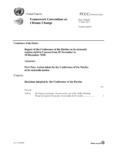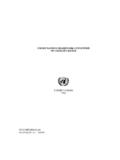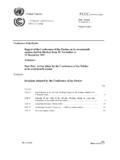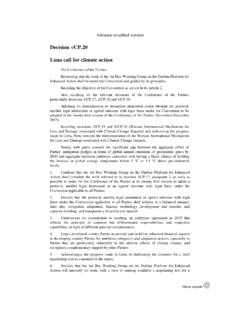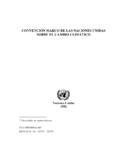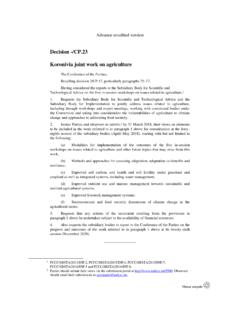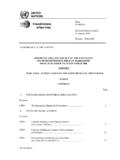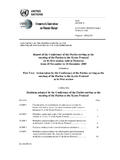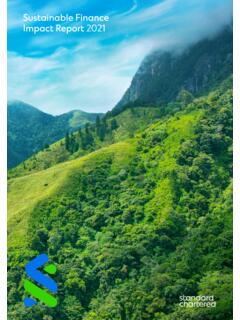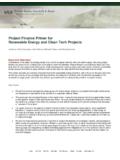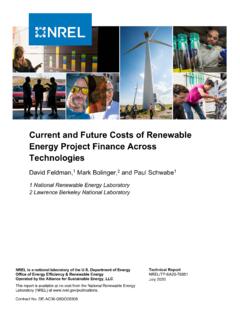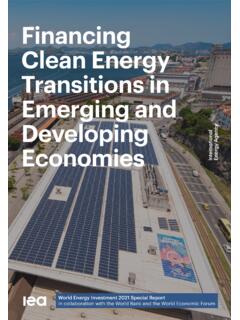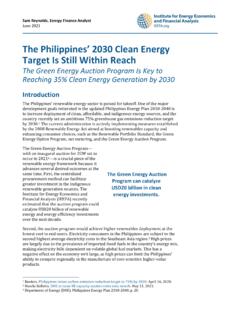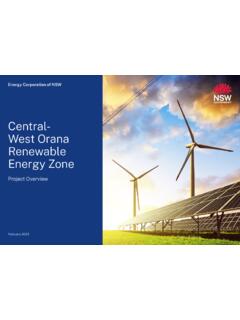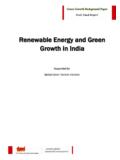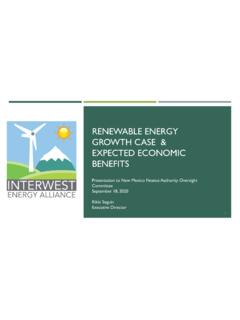Transcription of GHG Accounting for Grid Connected Renewable Energy …
1 INTERNATIONAL FINANCIAL INSTITUTIONS TECHNICAL WORKING GROUP ON GREENHOUSE GAS Accounting IFI TWG - AHSA-001 GHG Accounting for Grid Connected Renewable Energy Projects Version Date: July 2019 IFI TWG - AHSA-001 GHG Accounting for Grid Connected Renewable Energy Projects Version Date: July 2019 2 of 8 TABLE OF CONTENTS Page 1. OVERVIEW .. 3 2. DEFINITION .. 3 3. SCOPE FOR CALCULATIONS .. 3 4. project OUTPUT .. 4 5. BASELINE EMISSIONS FACTORS .. 4 6. METHODOLOGICAL APPROACH FOR THE COMMON DATA SET.
2 5 7. CALCULATION OF THE OM .. 5 8. CALCULATING THE BM .. 6 9. COMBINING THE OM AND BM TO CONSTRUCT THE CM EF .. 7 10. CALCULATING BASELINE EMISSIONS .. 8 IFI TWG - AHSA-001 GHG Accounting for Grid Connected Renewable Energy Projects Version Date: July 2019 3 of 8 1. Overview 1. This note sets out a harmonized approach for assessing the mitigation benefits, or net greenhouse gas (GHG) emissions, of Renewable Energy (RE) projects in accordance with the International Financial Institution (IFI) Framework for a Harmonized Approach to Greenhouse Gas A Technical Working (TWG)2 Group of IFIs has agreed to use a common set of emissions factors for GHG Accounting of electricity production from Renewable Energy (RE)
3 The purpose is to harmonize GHG Accounting through the application of common emissions factors to RE GHG calculations. Further iterations of this approach note will include the treatment of off-grid RE activities. 2. Definition 1. For this document, the definition of Renewable Energy (RE) for electricity production follows the RE project typology defined by the Common Principles for Climate Mitigation finance Tracking:4 (a) Wind power. (b) Geothermal power. (c) Solar power (concentrated solar power, photovoltaic power).
4 (d) Biomass, liquid biofuels, or biogas power. (e) Ocean power (wave, tidal, ocean currents, salt gradient, etc.). (f) 2. If the pre-investment facility has not reached the end of its technical life, the approach set out in the IFI Approach to GHG Accounting for Energy Efficiency Projects6 shall be followed. 3. Scope for calculations 3. GHG calculations should take the following points into consideration, where applicable/appropriate: 1 Available here.
5 2 The IFI TWG for this methodology includes technical specialists from ADB, AfDB, AFD, EBRD, EIB, GEF, GIB, NIB, NEFCO, IDB, IFC, and WB, with support from the UNFCCC secretariat; to be widened to include more IFIs as work progresses. This note will be reviewed and updated periodically by the TWG. 3 This approach is generally consistent with similar approaches to account for GHG emissions from a broader set of power generation projects. 4 Available here (link 1; link 2). 5 Pumped storage is not considered Renewable Energy for the purpose of this document.
6 6 Available here. IFI TWG - AHSA-001 GHG Accounting for Grid Connected Renewable Energy Projects Version Date: July 2019 4 of 8 (a) Construction emissions for RE projects may be excluded, where forms of Renewable Energy are generally acknowledged to have low construction/lifecycle emissions. (b) Include GHG emissions from large reservoirs associated with hydropower projects. (c) Include biomass feedstock-related life-cycle (d) Include geothermal fugitive emissions. 4. project Output 4. Assumptions for power generation capacity (MW) and project Energy output (MWh) should be based on the project appraisal documentation and the due diligence documentation of IFIs.
7 5. Baseline Emissions Factors 5. The main principles and assumptions for the baseline emissions factors include: (a) Electricity produced from Renewable sources and supplied to a grid, unless otherwise specified8, will avoid emissions that would otherwise be generated wholly or partly from more carbon-intensive sources. (b) For the purpose of promoting greater harmonization, the IFI GHG Accounting TWG (IFI TWG) maintains a common dataset containing Default Emissions Factors (DEFs) for countries and interconnected grids where applicable.
8 The default emissions factors apply to electricity generation in a country and currently do not consider the impact of interconnections with neighbouring countries. The impact of a project on a country with interconnections is determined on a case-by-case basis by the IFI. Where IFIs co- finance such projects, harmonisation of the assumptions is encouraged. The approach to determine default emissions factors will be further refined as more data/information become available for countries with a significant level of interconnection with neighbouring countries (including countries, which are part of a power pool).
9 (c) The common dataset of DEFs will be updated at-least once in two years under the responsibility of the TWG. Where an IFI has conducted its own country baseline study, the results of this study may be submitted to the TWG for consideration of inclusion in the common dataset during future annual updates. (d) In those cases, where a project is replacing specific planned or existing generation capacity, each IFI is free to conduct its own assessment, which may be shared with the TWG. In all other cases, the DEF approach and the common dataset described will apply.
10 7 Life-cycle emissions may include emissions due to storage, biomass collection, processing and transportation. 8 See Scope for Calculations (section 3). IFI TWG - AHSA-001 GHG Accounting for Grid Connected Renewable Energy Projects Version Date: July 2019 5 of 8 6. Methodological Approach for the Common Data Set 6. The common dataset containing DEFs is constructed using a Combined Margin (CM) for the grid that is comprised of an Operating Margin (OM) and a Build Margin (BM).
